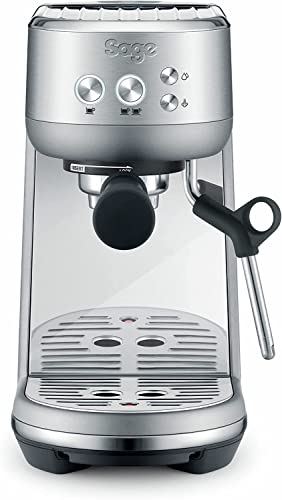Espresso Maker - A Must-Have For Home Baristas
Espresso is a dark, strong drink made by pushing hot coffee through finely ground coffee grounds that are tightly packed. It is the base of many popular coffee drinks at the cafe.
espresso machine uk (also called an espresso maker) controls a number of variables to make an excellent cup of espresso. This includes the temperature of water and its pressure as well as how tightly packed the coffee is.
Origins
The espresso machine is a device which makes use of high pressure to push small amounts of water close to boiling through finely ground beans. The resultant drink is stronger than drip coffee, more concentrated, and served in smaller cups. This is a great choice for those who need a strong cup of espresso but want it quickly!
The first espresso machines were invented in the 19th century. At the time, coffee was a huge industry, but brewing it took way too long. People were impatient and needed an instant cup of coffee!
Angelo Moriondo of Turin patented one of the first coffee machines in 1884. The machine's name was "New steam machinery, for the economical and instantaneous preparation of coffee beverages. Method A." Moriondo."
Luigi Bezzerra, Desiderio Pavoni and other Milanese manufacturers improved and adapted this machine. They incorporated the portafilter, multiple brewheads and other innovations that are associated with espresso machines today. Their machine was called Ideale and it wowed audiences at the 1906 Milan Fair. Nine out of 10 Italian homes have Moka Pots. Moka Pot.
Variations
Espresso is more intense in flavor than coffee. It pairs well with milk to make café favorites like cappuccinos or lattes. Its strong flavor is also evident in baked goods recipes and even marinades.
There are four primary types of espresso maker that include manual levers semi-automatic, automated, and super-automatic machines. Each type has a different way of creating pressure for extracting the espresso.
A manual lever machine makes use of a piston made of metal that presses water through the ground. It's a perfect blend of manual control and mechanized consistent. You'll still have the grind and tamp shot for yourself however you are able to control the pressure and temperature of the water better.
Moka pots, a different manual espresso maker works similar to modern espresso machines, which are powered by pumps. Inside an airtight tank, boiling water creates steam, which is then forced through the bottom chamber, into a basket that is filled with ground coffee, and then into a metal filter, where it is pumped into the top cup. These machines are cheaper, but can only produce 1-1.5 bars of steam pressure. This is not enough to make espresso.
Ingredients
With a bit of time and practice espresso makers can aid baristas in the home to make popular cafe drinks like cappuccinos, lattes and flat whites. You can add flavored syrups or extracts to espresso shots for a rich drink like an espresso martini.

For a great espresso drink you'll need top-quality beans, fresh milk and sugar. To ensure a consistent extraction, choose coffee beans with a special espresso label. Blend them finely. Try different roasts until you find the one that matches your preferences.
You'll need a burr grinder to grind the beans into a uniform texture. The espresso machine comes with a portafilter, which holds the grounds, and the tamper, which is used to pack in the coffee into a tightly packed.
You'll also require an espresso set and a steamer to make the silky aerated milk so characteristic of espresso drinks. Certain machines have steam wands that are built-in that can make this process faster and easier. You will also need to descale your machine regularly by running water and vinegar solution through the system.
Techniques
Espresso Brewing is the process of creating pressure to quickly extract the intense flavor from finely ground, dark-roasted coffee that is tightly packed into a 'puck. This method of brewing creates a strong espresso shot known as espresso. When done properly, espresso features a luxurious crema (or dense foam) over the top.
The majority of espresso makers utilize high-pressure water to push through finely ground coffee under high heat. This differs from the Moka Express, which uses heat to remove coarsely ground coffee. This produces an espresso like beverage that can be mixed in water or milk to make different drinks, like lattes or cappuccinos.
The Moka Express is a cheap, simple appliance. Other espresso machines are more complicated, expensive and come with a variety of drinks. The most popular lever machines are Italian designed and make use of a spring-loaded arm to pour hot water from a cylinder into the portafilter. The barista can adjust variables such as water temperature and grind size shot-by-shot to get the most optimal results. These machines were crucial in bringing espresso into greater recognition throughout Italy and Europe.
Equipment
A high-quality espresso maker needs to be able to extract both soluble and insoluble solids from finely packed, tightly ground coffee. This is made possible by controlled variables and pressure such as temperature and grind size. The flavor is also a result of a variety of factors, including the beans used, as well as the method in which they are brewed.
There are many types of machines that create espresso, but the most common is the semiautomatic machine. It uses an electrical pump to force the water through the grounds. The user can also do the grinding and the tamping. These machines tend to be the most affordable but aren't as consistent as spring pistons or other manual designs.
The higher priced lever models come with an calibrated piston that will do the work. They're more tolerant than spring piston machines however they still require some expertise to use properly. They typically require some maintenance, and require you to heat and disassemble the portafilter and the piston each time.
